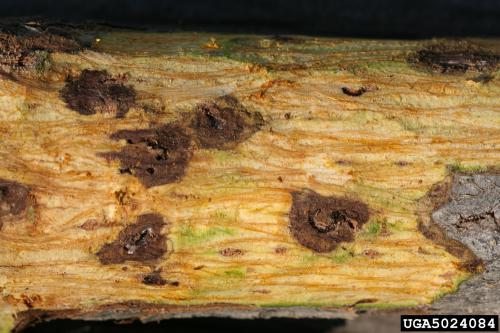Canker diseases on shade and forest trees: Part 2
How Michigan residents can help be on the lookout for some of these types of canker diseases and other types of tree problems.
Chestnut blight, caused by the Endothia parasitica fungus, was a major invasive pest introduced to the eastern forests of the U.S. in the early 1990s. It was likely imported into this country on infected chestnut tree nursery stock from Asia. The American chestnut was, by all accounts, a wonderful tree known for its sturdy and rot resistant lumber and its edible nuts. But nearly the entire population of American chestnuts were killed by the canker fungus – leaving only scattered, isolated pockets of chestnut trees that still survive today – including in Michigan.
In contrast, a somewhat “new” canker disease caused by the fungus, Geosmithia morbida, has recently been discovered east of the Mississippi River, called thousand canker disease (TCD) of walnut. As the name implies, it causes many tiny sized diffuse cankers to form underneath the bark of walnut twigs and branches. As these tiny cankers spread, they ultimately kill the infected branch – causing branch dieback within the crown of an infected walnut tree. In some cases, an entire walnut tree may be killed by TCD.
TCD is spread to healthy walnut trees by a small insect known as the Walnut twig beetle. This beetle can carry spores of the pathogen Geosmithia morbida, (obtained from boring into other infected walnut tress) and spreads them to uninfected trees as it tunnels beneath the bark of twigs and small branches. Because many beetles can attack a walnut tree at the same time, the result is a multitude of cankers being formed (see photo).

Canker | Whitney Cranshaw of Col. St. University

Map by www.thousandcankers.com
Fortunately, TCD has not yet been found in Michigan, but the fungal pathogen that causes it or the twig beetle that spreads it – have both been found in Ohio and Indiana (see map), posing a real threat to Michigan walnut trees.
Interested Michigan residents can help keep TCD out of Michigan by becoming Sentinel Tree volunteers with the Michigan Eyes on the Forest and Sentinel Tree Network. Funded by the Michigan Invasive Species Grant Program, the Michigan State University (MSU) “Eyes on the Forest Project” links research and outreach projects through the MSU Department of Entomology and Michigan State University Extension. For more information, please visit the Michigan Eyes on the Forest webpage or the Midwest Invasive Species Information Network webpage. Preventing the introduction of new invasive species is the goal of the Michigan Sentinel Tree Network and Eyes on the Forest Project.



 Print
Print Email
Email




